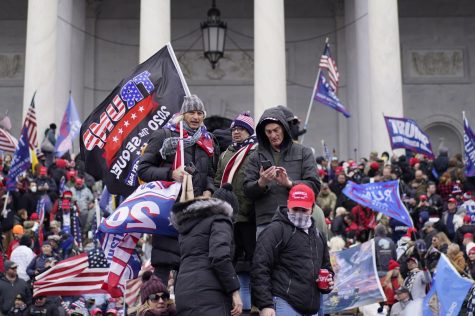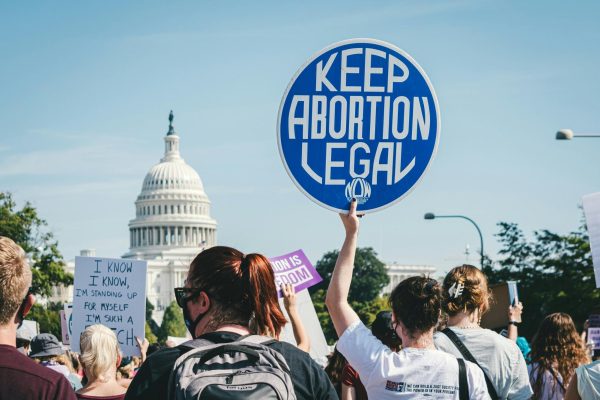OPINION: Capitol Hill protests depict racial disparities in policing
Jon Cherry – TNS
WASHINGTON, DC – JANUARY 06: Pro-Trump protesters gather in front of the U.S. Capitol Building on January 6, 2021 in Washington, DC. A pro-Trump mob stormed the Capitol, breaking windows and clashing with police officers. Trump supporters gathered in the nation’s capital today to protest the ratification of President-elect Joe Biden’s Electoral College victory over President Trump in the 2020 election.
The complete lack of control during the Capitol Hill riots that occurred this past Wednesday only reinforced the already clear disparities in policing. Following the riots, the DC Metropolitan Police Department reported that it made 52 arrests relating to the unrest. On June 1 of last year, 289 people were arrested due to the Black Lives Matter (BLM) protest in Lafeyette Park, which is roughly 5.5 times higher than those at Capitol Hill. The Washington Post reported that 14,000 arrests were made nationwide during the months of protests for racial justice.

During the protest at Lafeyette Park, not only were there more arrests made, but there was a heavy police and National Guard presence already awaiting protestors. When they did not disperse, smoke bombs, pepper spray, batons and other means of force were used against the protesters. The National Guard Commander Adam DeMarco released a statement prior to testifying before the House of Representative stating that the protesters were exposed to “an excessive use of force” and that he found it “deeply disturbing.” Several high-level government officials such as the Chairman of the Joint Chiefs of Staff General Mark Milley and Former Defense Secretary James Mattis reaffirmed this statement, agreeing that the military should not deploy its power against their own citizens when they are acting peacefully and in accordance with the right to assemble.
In contrast, as many Americans watched on television, the rioters at Capitol Hill overtook the police barrier by pushing back against the officers, (some were shown on video hitting the police) and making their way into the Capitol. Crowds of thousands were shown surrounding the Capitol, while many were inside continuing to terrorize staff and cause the members of Congress to be evacuated. While this unfolded, the situation only seemed to be escalating, with the rioters scaling the building, climbing onto structures and hanging Trump flags onto the Capitol. Indoors, they were shown walking into the rotunda (yes, walking and taking pictures) as if this were just a normal afternoon tour of our nation’s capital and not an attempted coup. Meanwhile the police made little attempt to stop them, some even taking selfies with the MAGA supporters. An armed standoff occurred at the door of the House chambers, while others were left to roam the Capitol freely. Some made their way into the offices of officials such as House Speaker Nancy Pelosi, while a man was able to find his way into the president of the Senate’s chair and yell “Trump won the election!”

This situation took hours to de-escalate, as the National Guard was called into action by Vice President Pence, not President Trump himself, who was not hesitant to deploy the National Guard to Kenosha, Philadelphia, or even Layfette Park earlier this year.
In tweets that have since been deleted, the President and his daughter, Ivanka Trump, both used the term “American Patriots” to describe the mob that overtook the capitol. While they attempted to use the terminology to appeal to supporters and dissipate the crowds, the difference in classification between these rioters and the BLM protesters is startling. This parallels many statements that the President has made, including the Charlottesville “Unite the Right” rally statement when he said that there were “very fine people on both sides” when referring to the clash between white supremacists and counter protesters. If there is one thing that Trump does not want to do, it would be to anger his supporter base. While I recognize that not all of those who support Trump are white supremacists, it would be irresponsible and naïve to not mention that there is a clear association between those who freely bear Confederate and Nazi flags and their support of the current president. Trump’s supporters are compelled by his hateful rhetoric that often blames and scapegoats both specific people and groups.

The lack of police action towards the rioters only illuminates the countless issues when it comes to fair policing in this country. “Law and Order” is a phrase only used when it is convenient, or when it fits a political narrative. When protesters are calling for the reform of a system that has historically been used to oppress black and brown communities, there are suddenly cries of “law and order!” from the sidelines. If there are people in our country who did not fully grasp the term “white privilege” before today, then they are experiencing a new reality. White privilege allowed these protesters to break down the police line blocking the entrance to the Capitol and continue to walk into the chambers and offices of government officials. White privilege allowed for the crowd to not experience the typical treatment of smoke bombs, tear gas and rubber bullets that BLM protesters often faced this past summer.
Protesters associated with the BLM movement would not have been able to make it past the guardrails at the Capitol.
We’ve all heard the stories of Black men and women losing their lives at the hands of law enforcement for much less. In contrast, these (mostly white) supporters of the president were able to attack a major federal building, taunt law enforcement and escape without a scratch. Very few will do time in federal prison, and the overwhelming majority were able to return home and share the stories of their “fight for democracy.”
On Feb. 18 , 1970, Abbie Hoffman, Jerry Rubin, David Dellinger, Tom Hayden and Rennie Davis (later known as the Chicago 7) were charged and convicted with crossing state lines with the intent to start a riot. They were part of various groups that were protesting the Vietnam War in Chicago during the 1968 Democratic National Convention. To be clear, they were quite bogus charges that were created to “make an example” out of these men for those who continued to protest. Although they were later released due to a successful appeal, their case is certainly relevant when discussing the events at the capital this week.
While it does not further expand my reasoning on the racial treatment disparities in policing, it calls into question who was responsible for inciting the riot that took place on Jan. 6. Trump’s incendiary language was a clear motivator of the Capitol riot, but I do not doubt that there were others in the group who wanted to take more drastic measures. These rioters not only jeopardized the safety of every member of Congress and their staff but disrupted the democratic process of certification of the Electoral College votes.
However, much like the BLM protesters, the Chicago 7 were protesting to upend a system that took advantage of the people it was supposed to protect. With BLM it is the law enforcement, and with the Chicago 7 it was the Congress who sent many of America’s young men to war. When the government feels threatened, it will use its resources and military force against the threat. It was easy to use force against the citizens protesting the Vietnam War, and it was easy to use force against those protesting police brutality in this country. However, the rioters at Capitol Hill were not considered a threat by this current president, as he was not inclined to meet them with force. There were no lines of police or National Guard heavily clad in riot gear awaiting their arrival.
There are parallels in our nation’s history that affirm the usage of force against our citizens to lack consistency. For anyone who still held doubts about policing in this country, this incident made clear who the system chooses to protect. Change surrounding this issue can only come from aggressive and systematic policy adjustment towards community policing models. Additionally, those in power must publicly acknowledge that the rioters yesterday were domestic terrorists, and that the BLM movement does not share any commonalities.













Marilyn Goldberg • Jan 9, 2021 at 11:36 am
Another great article from my granddaughter Hannah as she puts into perspective what happened on Wednesday January 6, 2021
I couldn’t believe what I was seeing on tv but it was true facts not as Trump supporters call fake news
Thank you Hannah